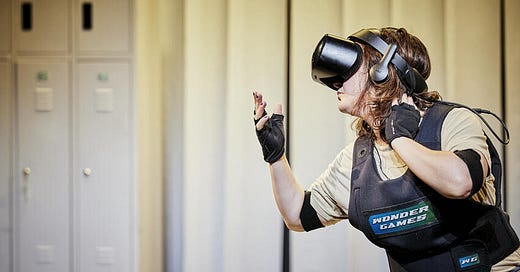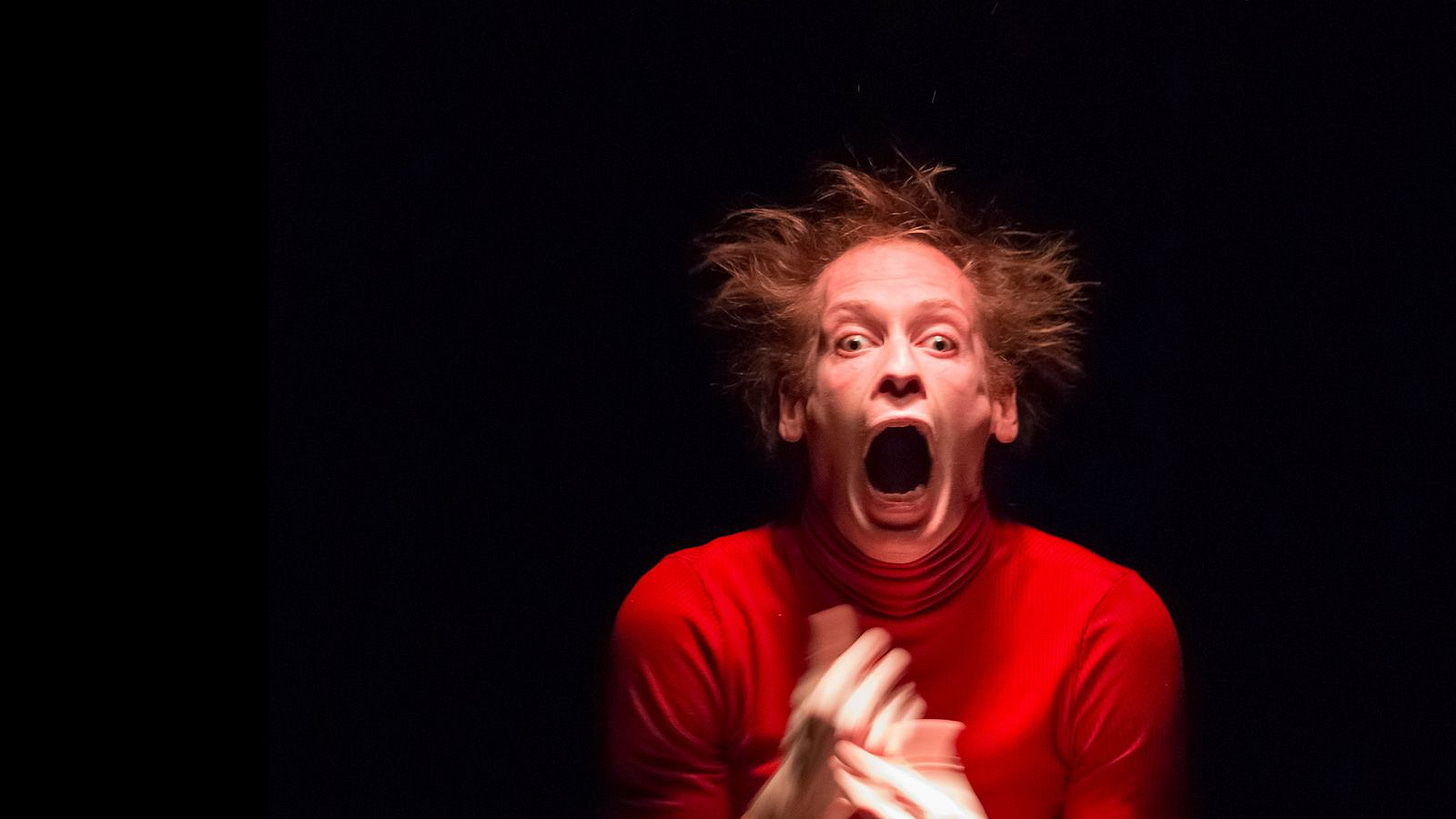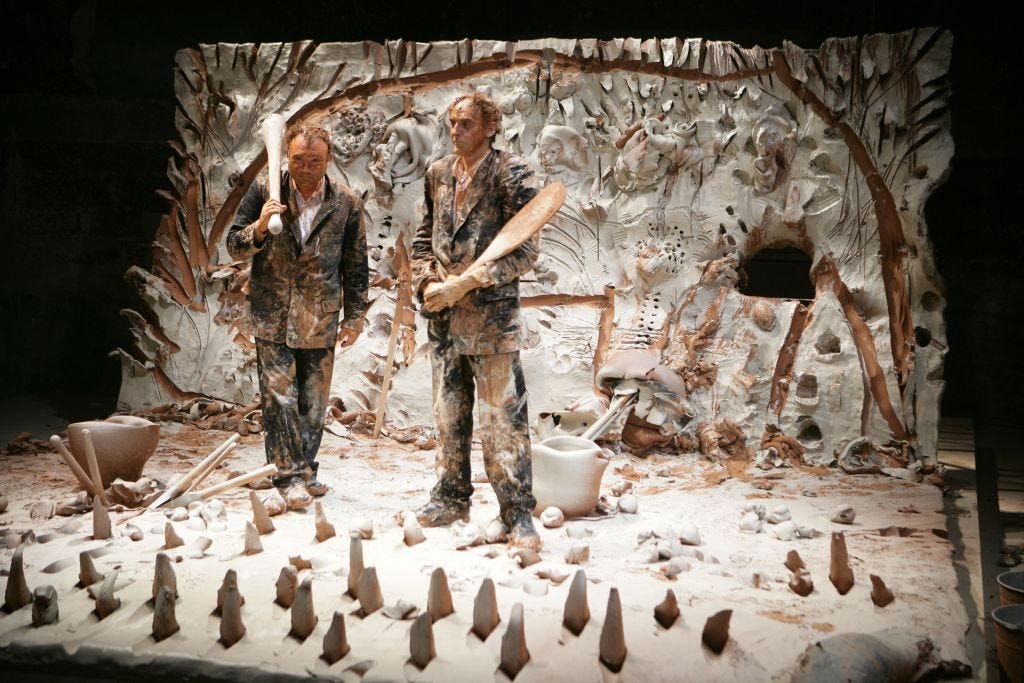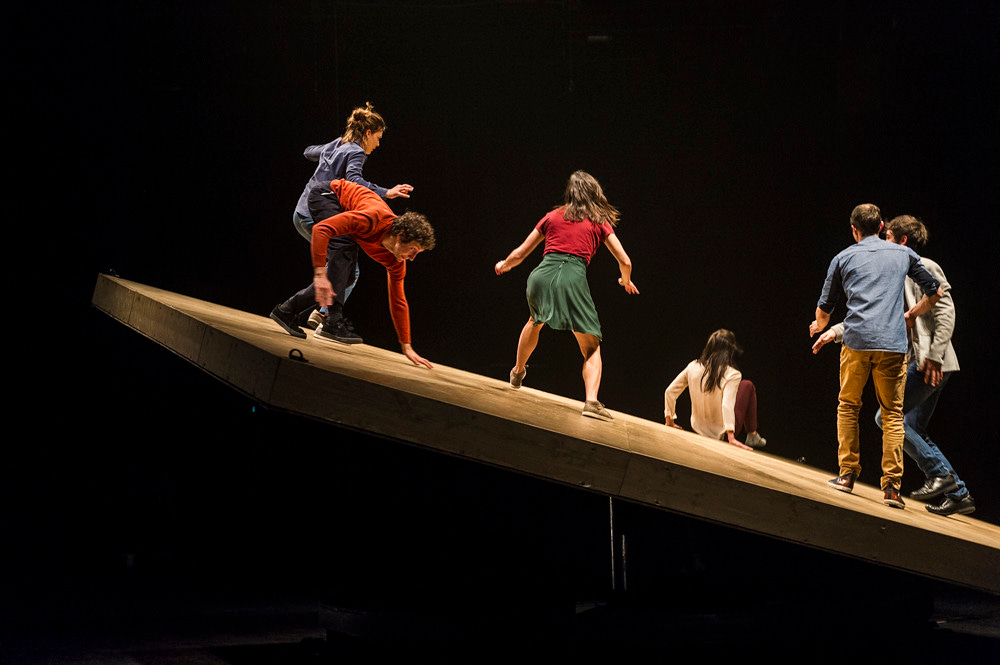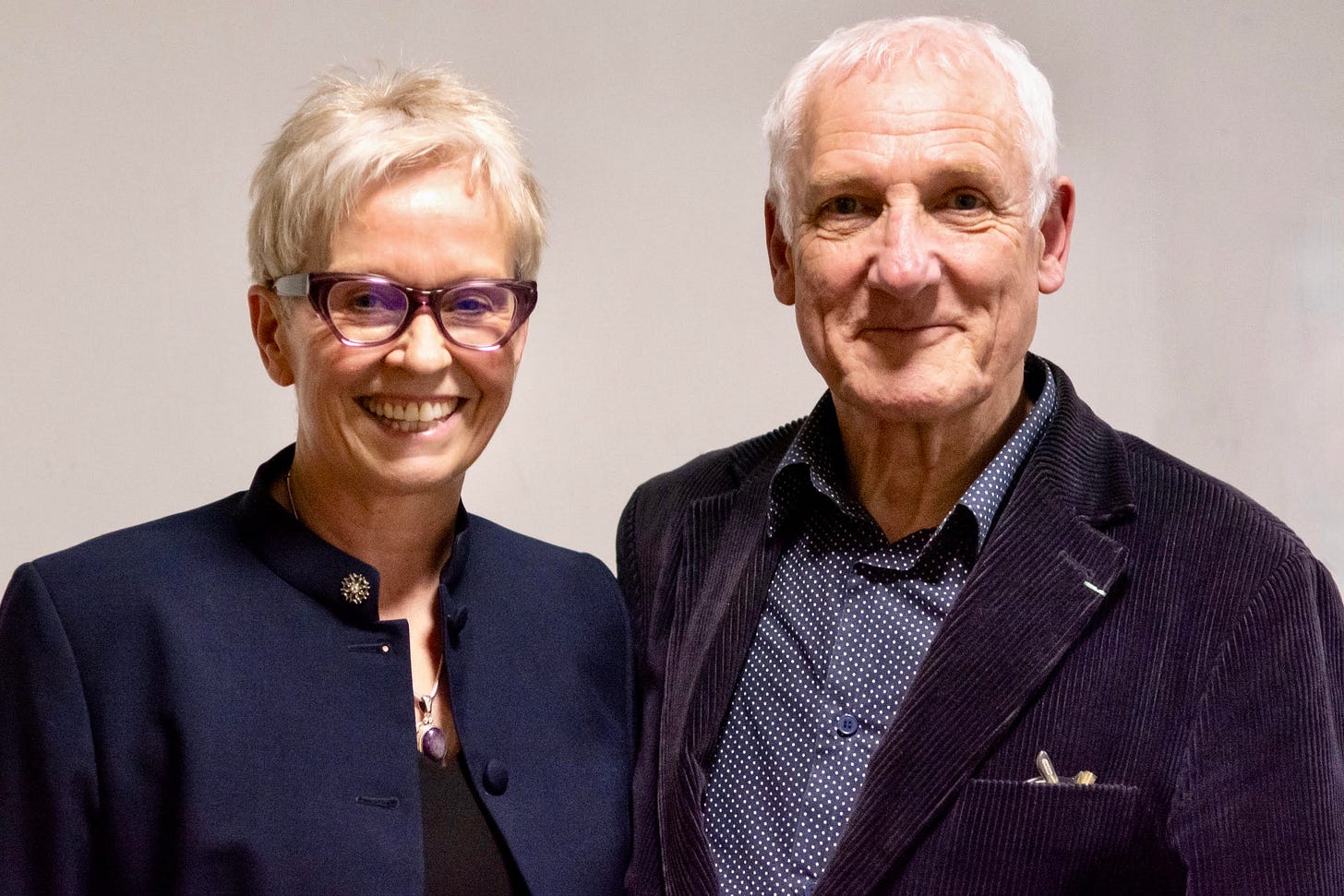More than words: The legacy of the London International Mime Festival
A look back at a festival which has been bringing some of the world's best visual theatre to London for the past 47 years.
Welcome to Café Europa, a weekly newsletter dedicated to European theatre.
Hello to all my new subscribers. This week’s edition takes the form of a look-back at the weird and wonderful London International Mime Festival, which for 47 years brought the very best of visual and physical theatre to London. I spoke to co-directors Helen Lannaghan and Joseph Seelig about why they felt the need to bring the festival to an end last year and what we can expect from them next.
If you enjoy reading this newsletter, then please consider sharing it. If you really enjoy it and want to become a paid supporter, that would be lovely. It really makes a difference. The newsletter is a pleasure to write, but it is a lot of work. This year, as promised there will be more bonus editions for paid subscribers, with the next one due this weekend. As is the way these days, I also have a Ko-fi account.
A woman arrives at a virtual-reality gaming facility and puts on a headset. The game she has selected is called the Titanic Experience, a virtual reality recreation of the James Cameron movie, in which she gets to experience everything that Kate Winslet’s Rose experiences onscreen as she were going through it herself.
For the next 20 minutes, we watch as the performer wearing the headset jigs and wriggles her way across the stage, or gets hot and heavy in the backseat with Jack, all the while watched over by a bored employee. It’s a one-joke routine but it’s fabulously physically executed and absolutely bloody hilarious. We’re with her through every beat of Rose’s journey, every kiss, every king-of-the-world, even as things become increasingly terrifying and traumatic as the ship starts to sink.
This was one of four unsettling vignettes that made up Flesh by the Belgian physical theatre company Still Life. Created and directed by Sophie Linsmaux and Aurelio Mergola, it went down a storm at the Avignon Festival in 2022, before playing the Barbican Centre as part of the London International Mime Festival (LIMF) last year.
January is traditionally a quiet time in UK theatre, following the hecticness of December. Pantomimes are wrapping up and there aren’t all that many major openings. For years, LIMF afforded audiences the chance to see something highly visual and/or disarmingly weird during these dark midwinter days.
Founded in 1977, LIMF was a celebration of wordless and multi-disciplinary work, with mime being an umbrella term for all forms of physical and visual theatre, including circus, clowning, dance-theatre, object-theatre, puppetry, live art and juggling. The festival started life at the Cockpit Theatre, where it was codirected by Nola Rae and Joseph Seelig and initially focused on British artists, expanding to include international artists in 1978. Helen Lannaghan joined Seelig as co-director in 1987 and the pair have worked together ever since, the festival presenting almost 800 companies it its 47-year history, until its final edition last year.
With so many to choose from, it's hard to pick a favourite, so I asked some other critics about the shows that made the greatest impact on them.
Literary manager and circus enthusiast Francesca Peschier cites Only Bones, a show with “rules created by circus artist and extremely bendy human Thom Monckton.”
The show could include one light, one human, no props, no dialogue and nothing that could meaningfully constitute a set. It did not necessarily need to include Thom Monckton. Yet it his strange joint popping mix of delicate contortion and quick visual gags that summarises his magic - even when embodied by new bones, in the form of Trygve Wakenshaw, who performed it at the festival in 2020 and brought a new energy to it; less Puckish, possibly malevolent, creature from another astrological plane, more impossibly buff slenderman with jokes.
Writer and narrative designer William Drew chose Miquel Barcelo and Josef Nadj’s Paso Doble, which was part of the 2008 LIMF.
It involved the two artists (a sculptor and a choreographer respectively) and a huge wall of clay in the middle of the Barbican’s main stage. The piece was wordless, and the clay acted as the material, the stage set, the costumes, the obstacles to overcome and a record of everything that we’d collectively witnessed. In the end, they disappeared into the clay wall, sucked into the canvas. It was a joy to watch these two men take playfulness so seriously. The work felt rich in meaning but also completely accessible to anyone. We all shared in the joy of spectatorship and in the envy of not being able to jump up on stage and throw some clay around ourselves. My memories of it are so vivid, I’m incredulous it was fifteen years ago. To this day, it’s one of the most perfect pieces of performance I’ve ever seen, while transcending performance itself as it turned its stage into a document.
Critic and author of the excellent Running the Room: Conversations with Women Theatre Directors, Rosemary Waugh offers this:
I love LIMF. My most enduring memories of it, however, are not from watching the actual shows but from talking to the people who created them. For several years I was lucky enough to work on a series of snippety interviews with 5-6 of the programmed artists as part of the festival’s promotion. It became a highlight of my whole year/career (and a bright light in SAD-tinged January), always somehow resulting in these life-altering conversations with artists whose minds were wired to a different, brilliant frequency to the rest of us dull mortals. My favourites remain the lovely Sean Gandini, who talked about being immersed in Merce Cunningham and the order and chaos of his choreography, and the equally lovely Amit Lahav, who spoke about how Gecko’s shows tap into the audience’s subconscious, so everyone comes out thinking the piece is personally about them. I had a similar reaction to doing those interviews. I came out feeling like Sean and Amit had somehow saved my life – or redirected the course of it, perhaps.
My personal pick would be Yoann Bourgeois’ He Who Falls from 2016, which saw a group of performers teeter on top of - and occasionally dangle from - a massive wooden platform as it swings, tilts and pivots. It was a glorious mix of the delicate and perilous – there were several proper holy -shit moments - but also poetic and moving in its depiction of instability and precarity.
So now LIMF is no more, what comes next? Curated by Lannaghan and Seelig, 2024’s MimeLondon looks more like a way of cementing the legacy of LIMF, than a replacement festival. Taking place across London between from 12th January – 17th February, it features eight shows – including Gecko’s Kin at the National Theatre and Ockham’s Razor’s acrobatic adaptation of Thomas Hardy’s Tess at the Peacock Theatre – as well as a programme of theatre workshops. Read on for more on this new format and why the festival could no longer go on in its previous incarnation.
An interview with Helen Lannaghan and Joseph Seelig
What exactly is MimeLondon? How will it differ from London International Mime Festival?
Our desire is to continue promoting contemporary visual theatre, but not in the context of a festival. After 47 years, and however much we knew that LIMF would be missed, we felt that it was time to stop, to get off the festival treadmill. Nothing lasts forever and LIMF lasted successfully for longer than most. It wasn’t an easy decision and was taken over quite a long period of time.
A word about the past: ACE supported the festival from the outset. We have been a National Portfolio Organisation (NPO) since that scheme started. Historically our grants, when compared with similar scale London festivals, were always much smaller and occasional percentage increases were therefore also always smaller. In return for our subsidy, we produced a very big programme, our budgets always based on minimal overheads and very high paying attendance figures which we invariably achieved. But cost increases after Covid and Brexit simply made it unrealistic to continue given that ACE’s grant would remain on standstill even were we to be successful given the levelling-up agenda and our London centric programme.
Touring work outside London would only add to costs and to the already over-heavy workload. The requirements that needed to be fulfilled to maintain the grant, reporting and monitoring etc, would require more people and divert money from the already over-stretched artistic budget. Venues have less money too, especially outside London, and it can’t be artists who have to be asked to absorb the shortfall. We gave up our office in the first lockdown. There were no further possible cuts to be made to budgets and we could not responsibly undertake the greater, probably untenable risk involved to produce what we felt would be a worthwhile and major event.
As a result, we decided not to apply to renew our NPO status. LIMF concluded as the UK’s longest running international theatre festival, and solvent. It had put visual theatre on the map, and provided an annual focus for such shows, attracting ever growing audiences.
However, it became clear that our regular London venues want us to continue in some shape or form because they see great value in the work we present and the diverse audiences we bring to their theatres. Also, we had also invested a small amount of co-commissioning money in four British companies’ new shows and wanted to honour them with a sort of ‘exit' season - Ad Infinitum, Gecko, Ockham’s Razor, and Vamos. But the festival had always been international, and it was very important that this new platform, MimeLondon, if it were to work, should also showcase exciting international shows alongside their British counterparts. Hence, we have four international companies at the Barbican Pit.
MimeLondon isn’t just a different incarnation of LIMF. It’s a different concept, and anyone expecting another festival by a different name will be disappointed. What we can do without funding is necessarily much more modest. Our curation relies entirely on our partner venues for funding. We feel that the various performance forms we’ve championed under the banner of ‘visual theatre’ for almost half a century are well established and don’t need an annual festival to remind people of their existence. We want to encourage venues to include physical/visual theatre in their regular programming as a matter of course, not just as special events associated with a festival.
We will effectively just be curators not producers – finding and identifying work for the venues, which will then do all the necessary administration and cover the presentation costs. It means our years of experience and international networking can still be useful. How we pay ourselves, cover our research costs and maintain our website is another matter and we will need to find a solution if we are to continue beyond 2024.
How has LIMF evolved over the past 47 years? What changes in visual theatre making did you witness over the decades? What impact did advances in technology have on the kind of work being made?
The work we present has shifted in tone and subject matter from primarily comedy/variety and sketch-based work in the earliest years to productions of complexity and substance often dealing with serious topics and issues. This has certainly been aided by new technology, with sophisticated lighting, sound and video projection adding depth and quality to the work. The air of ‘fringe’ or ‘alternative’ has largely disappeared.
The most ambitious and accomplished UK companies have graduated from smaller studio theatres to producing work on the main stages, where overseas’ visual theatre companies (including Compagnie 111 / Aurelien Bory, Compagnie MPTA/Mathurin Bolze, Peeping Tom) better resourced than our own, had already paved the way.
Roughly how many festivals and showcases did you attend over the years? Do you have a favourite?
Our travel budget was always modest, so we were careful how we spent it. Mostly we travelled in Europe, which was where the best visual theatre work was produced. Before the advent of video trailers, we made more speculative trips to see one-off shows that either sounded interesting, had been recommended to us, or perhaps were the work of a company we had previously considered programming or had actually done so.
With the advent of video trailers, we’re able to see much more easily in advance whether something might fall within our remit (i.e. work that was visually led, but that wasn’t pure ‘dance’) before we commit money to going to see it live somewhere, which we always try to do.
Of course, it’s more cost-effective to go to a festival, where you can see multiple shows and with a fair chance, you’ll find something worthwhile. Other festivals have come and gone, but we still like the Mimos Festival in Perigueux, the Avignon Festival, and a whole host of exciting puppet festivals in Switzerland and Germany. Edinburgh was always our last call for late entries, and we’d always hold off closing the programme just in case we found something we thought would add an exciting element to the festival. It also helped that for many years Joseph was a director of the Hong Kong Arts Festival and the New Zealand Festival, and Helen worked with the Japan Festival and various others, all of which involved travel to see work which might be suitable for LIMF – and vice versa.
Did the challenges of programming LIMF change over the years? If so, in what ways?
Initially, the venues weren’t really involved in the artistic selection of work, so we could programme freely as artistic directors. Our venue colleagues had rarely seen the work we proposed and relied on our taste. The development of the role of venue programmers over the last 20-25 years meant, not unreasonably, that our partners wanted a voice in what they were taking for their theatres. Occasionally there were difficult moments when some programmers were envious of the work we presented at other festival venues, even though their finances and technical facilities just weren’t the same. It was tricky to manage. And then came more specific artistic and social requirements to satisfy funders (both ours and those of venues), so venues wanted work that despite our best efforts we could not offer, because it just wasn’t there.
Our audience has always been diverse, more than most we think. But we had to broaden our programming criteria to include more diverse work, including work with spoken text. This we had always tried to avoid, to maintain our distinctive identity.
A big challenge was also the very limited stage dimensions in most of small/mid-scale theatres, with rarely a stage depth beyond eight metres and a height of 4-6 metres, which precludes a lot of interesting work. It’s frustrating. The only venues with a stage big enough to accommodate certain shows were 1,000 seat theatres - far too large a capacity for the shows in question or unsuitable for other reasons. The loss of some iconic venues has also been key to the shifts on programming. The change of the ICA theatre into another gallery space in 2011 really affected our ability to programme edgy work that just didn’t sit comfortably in other spaces in the centre of town.
This week in European theatre
A round-up of festivals, premieres and other exciting upcoming events over the next seven days.
Refuge Festival – Mladinsko Theatre kicks off the year with a mini-festival of the work of Žiga Divjak (the subject of last week’s newsletter) at their New Post Office space. Between 10th-13th January audiences in Ljubljana will have a chance to see three performances – 6, Fever and Crises – alongside a programme of related talks.
New Plays: International – Between 10th and 21st January, London’s Royal Court presents a series of readings and performances of plays by writers from Barbados, Brazil, Jamaica, Mexico and the Philippines, all of whom have developed their work through the Royal Court’s International Programme. I’ve had a read of a couple of these plays and they’re fascinating.
The Emigrants – Legendary Polish director Krystian Lupa’s production of WG Sebald's Emigrants for Comédie de Genève was originally supposed to open last year only for performances to be cancelled there and at Avignon. Focusing on two of the four stories in Sebald’s exploration of exile and displacement, the four-hour production finally opens in Paris at Odéon-Théâtre de l'Europe on 13th January.
Thanks for reading!
If you have any feedback, recommendations, tips, or thoughts about this newsletter, you can reach me on natasha.tripney@gmail.com

